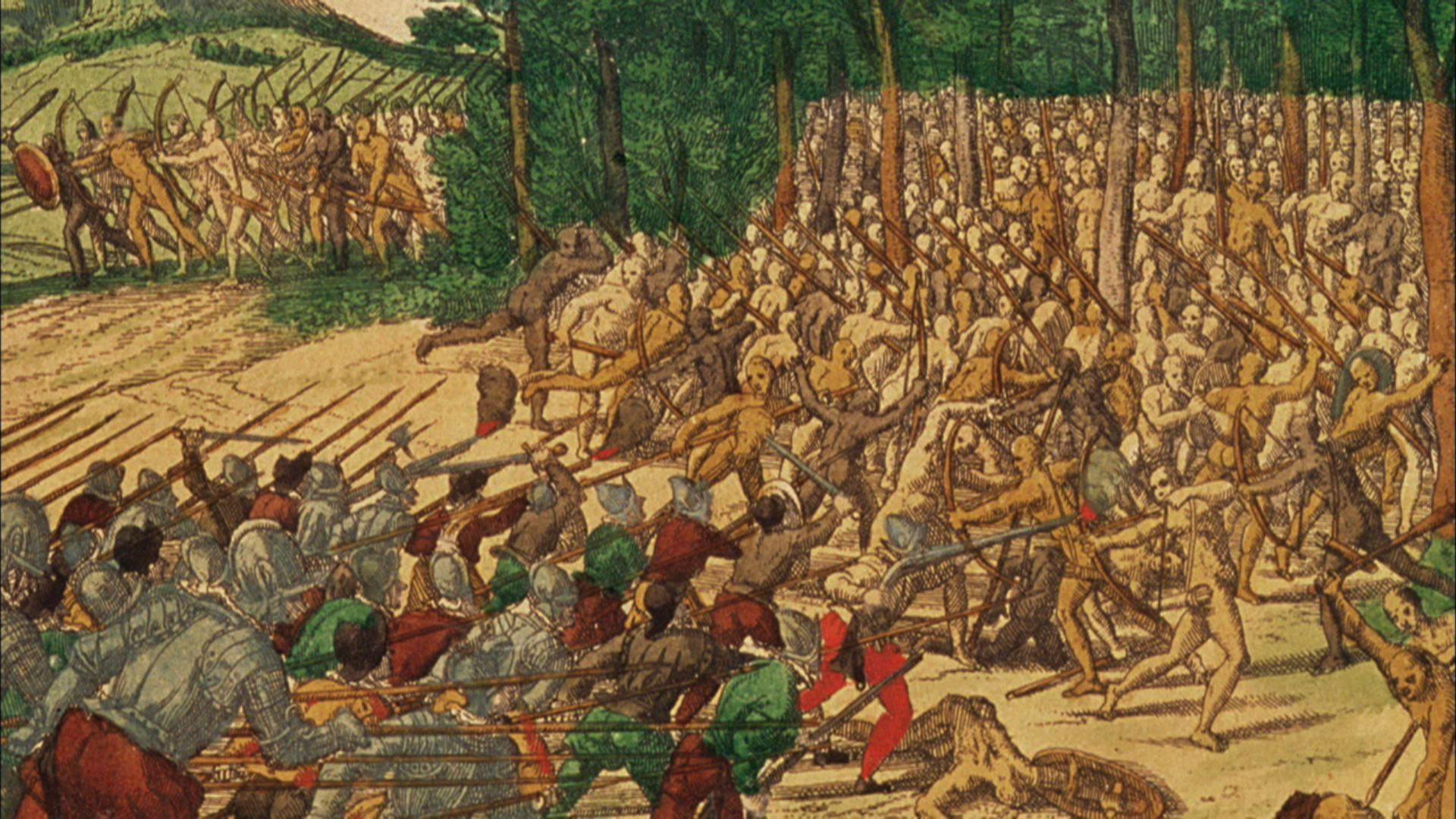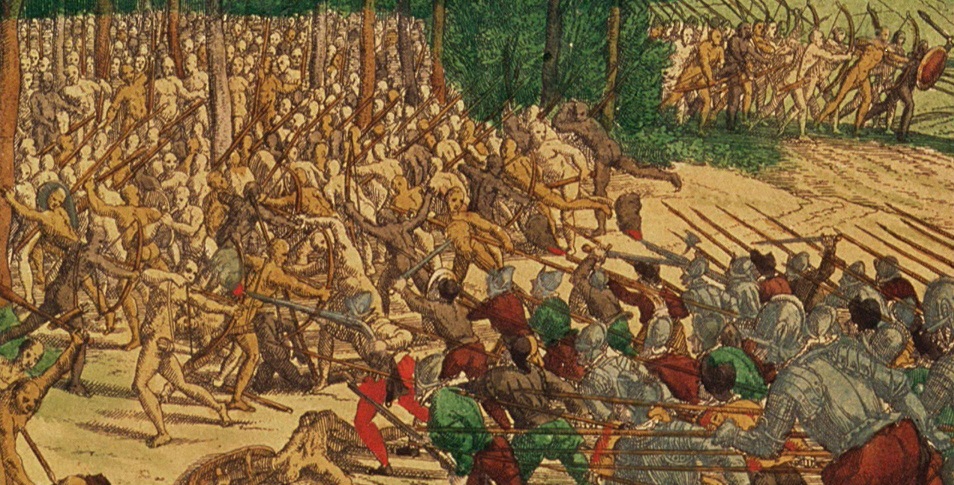
The Pueblo Revolt: A Fiery Chapter in America’s Indigenous Resistance
In the arid, unforgiving landscape of what is now New Mexico, a silent fury simmered for decades beneath the forced veneer of Spanish colonial rule. Then, in the sweltering heat of August 1680, that fury erupted. In an unprecedented act of unity and defiance, the Pueblo people, an array of distinct but culturally connected indigenous communities, rose up to expel their oppressors in an event that would forever be known as the Pueblo Revolt – the most successful indigenous uprising against European colonization in North American history.
This wasn’t just a rebellion; it was a desperate, meticulously planned struggle for cultural survival, spiritual freedom, and sovereignty. For twelve remarkable years, the Pueblos reclaimed their ancestral lands, dismantling the very symbols of Spanish domination and offering a fleeting, yet profound, vision of an independent indigenous future.

The Crucible of Oppression: Seeds of Rebellion
To understand the magnitude of the Pueblo Revolt, one must first grasp the depth of the oppression that preceded it. For nearly a century, since Don Juan de Oñate’s expedition formally established the colony of Santa Fe de Nuevo México in 1598, the Pueblo people had endured a brutal regime of Spanish exploitation and cultural annihilation.
The Spanish colonial system was a two-pronged assault: economic and spiritual. Economically, the encomienda system forced Pueblo men and women into grueling labor, cultivating crops, weaving textiles, and tending livestock for the benefit of Spanish encomenderos and the Crown. The repartimiento system further compelled them to perform communal labor for public works, often without compensation, diverting vital resources and labor from their own communities. Tribute demands, often paid in corn, blankets, and other goods, frequently left Pueblo villages on the brink of starvation, especially during periods of drought.
But it was the spiritual subjugation that cut deepest. Franciscan friars, accompanying the soldiers and settlers, launched an aggressive campaign to eradicate indigenous religious practices. Kivas, the sacred underground ceremonial chambers, were desecrated and destroyed. Kachina masks and effigies, central to Pueblo spiritual life, were burned in public auto-da-fés. Traditional dances were forbidden, and shamans, or "medicine men," were persecuted, flogged, or even executed for practicing their ancient beliefs. Baptism into Catholicism was mandatory, and those who resisted faced severe punishment.
"They sought to root out our very souls," recounted a descendant of the Pueblo people years later, echoing the historical memory of that period. "They told us our gods were evil, our ways were primitive. They tried to make us forget who we were."
Compounding these human-made miseries were natural disasters. The mid-17th century saw devastating droughts, leading to widespread famine and increased raids from nomadic Apache and Navajo tribes, who themselves were struggling for survival. Disease, brought by the Europeans, swept through the Pueblo communities, decimating populations already weakened by hunger and forced labor. The Pueblos, in their desperation, increasingly interpreted these calamities – the famine, the disease, the constant raids – as divine punishment for their abandonment of traditional ways and their forced acceptance of Spanish religion. This belief fueled a resurgence of indigenous religious practices, often conducted in secret, and intensified their hatred for their tormentors.
Popé: The Visionary Leader
From this crucible of suffering emerged a figure of immense spiritual authority and strategic genius: Popé, a Tewa religious leader from Ohkay Owingeh (San Juan Pueblo). Popé had personally experienced the brutality of Spanish rule, having been imprisoned and publicly flogged in 1675 along with 46 other Pueblo spiritual leaders, accused of witchcraft and apostasy. Three of his fellow prisoners were executed. This humiliation, rather than breaking him, ignited a fierce resolve.

Upon his release, Popé retreated to Taos Pueblo, a community known for its resistance and remoteness, where he began to meticulously plan the uprising. He claimed to have received visions from Pueblo deities, appearing as figures from the underworld in his kiva, instructing him to lead his people in expelling the Spanish. These visions imbued his message with powerful spiritual legitimacy, essential for uniting diverse Pueblo groups who often had their own rivalries and distinct languages.
Popé’s brilliance lay in his ability to forge an unprecedented alliance among the disparate Pueblos. From the Tiwas in the north to the Tompiros in the south, from the Zunis in the west to the Pecos in the east, his message resonated. He understood that success depended on simultaneous, coordinated action across hundreds of miles.
The chosen date for the revolt was August 13, 1680. To ensure synchronized action, Popé devised an ingenious communication system: the knotted cord. Runners carried a deerskin thong with a series of knots to each Pueblo. Each knot represented a day, and by untying one knot each morning, the Pueblos would know precisely when to strike. This simple yet effective method bypassed Spanish surveillance and ensured widespread participation.
The Flame of Freedom Ignites
However, the element of surprise was almost lost. Spanish authorities intercepted two runners carrying the cord, learning of the plot. Governor Antonio de Otermín immediately dispatched warnings and ordered the arrest of Pueblo leaders. But Popé, hearing of the arrests, swiftly changed the date. The revolt would begin not on August 13, but on August 10.
August 10, 1680, dawned with a deceptive calm across New Mexico. Then, in a terrifying crescendo, the Pueblos unleashed their fury. Attacks erupted simultaneously across the colony. Friars were killed at their missions, often as they prepared for Mass. Settlers were dragged from their homes and slain. Churches, the imposing symbols of Spanish religious dominance, were torched and razed to the ground. The scale and coordination of the violence shocked the Spanish.
The attacks were swift and brutal. Within days, over 400 Spanish colonists, including 21 of the 33 Franciscan friars, lay dead. The survivors, a mere 1,000 or so, including Governor Otermín, were forced to abandon their scattered settlements and consolidate in the provincial capital of Santa Fe and the village of Isleta.
The Pueblos then laid siege to Santa Fe. For nine days, the capital was surrounded, its inhabitants cut off from water and supplies. Faced with overwhelming numbers and relentless attacks, and with no hope of reinforcements, Governor Otermín made the agonizing decision to retreat. On August 21, 1680, the Spanish, a ragged procession of soldiers, settlers, and Christianized Indians, began their long, arduous march south down the Rio Grande, eventually reaching El Paso del Norte (modern-day Ciudad Juárez, Mexico). New Mexico was free.
Twelve Years of Indigenous Sovereignty
For twelve remarkable years, the Pueblos reclaimed their ancestral lands and their independence. Popé, now the de facto ruler, attempted to systematically purge all vestiges of Spanish influence. He ordered the destruction of remaining churches and Christian artifacts. He forbade the speaking of Spanish and commanded the burning of Spanish crops and the abandonment of European livestock, urging his people to return to traditional ways. Some historical accounts suggest he even tried to force Christianized Indians to wash off their baptisms.
This period of independence, however, was not a utopian return to an idealized past. Popé’s rule, while liberating, was also marked by internal challenges. The diverse Pueblos, united against a common enemy, now faced the complexities of self-governance. Popé’s authority, initially absolute, began to wane as he became increasingly autocratic, demanding tribute and suppressing dissent. Rivalries between Pueblos resurfaced. Furthermore, the persistent drought continued, leading to famine, and the nomadic Apache and Navajo raids, no longer deterred by Spanish forces, intensified, putting further strain on resources and lives.
These internal divisions and external pressures weakened the Pueblo confederacy, making them vulnerable to future Spanish incursions.
The Reconquest and a New Accommodation
The Spanish, licking their wounds in El Paso, never truly gave up on reconquering New Mexico. It was strategically important as a buffer against other European powers and a potential source of resources. In 1692, Don Diego de Vargas Zapata y Luján Ponce de León, a shrewd and determined governor, launched the reconquest.
De Vargas initially pursued a policy of persuasion, offering clemency to the Pueblos if they peacefully submitted. He successfully entered Santa Fe without bloodshed, symbolically reclaiming the capital. However, this "bloodless reconquest" was short-lived. Many Pueblos, having tasted freedom, resisted fiercely. Over the next four years, De Vargas engaged in a series of brutal campaigns, re-subjugating the Pueblos through force, siege, and executions. By 1696, Spanish rule was firmly re-established, but it was a rule fundamentally altered by the memory of the Revolt.
The Enduring Legacy
Perhaps the most profound impact of the Pueblo Revolt was not the temporary expulsion of the Spanish, but the lasting changes it wrought in Spanish colonial policy and, crucially, in the cultural resilience of the Pueblo people. The Spanish learned a bitter lesson: their previous methods of extreme oppression were unsustainable.
Upon their return, the Spanish adopted a more pragmatic, albeit still dominant, approach. The encomienda system was largely abolished, replaced by a less exploitative labor system. Franciscan friars were less aggressive in their attempts to suppress Pueblo religion, leading to a unique form of religious syncretism where Catholic saints and ceremonies coexisted with traditional Pueblo deities and rituals. The Spanish also granted the Pueblos greater autonomy over their internal affairs and recognized their land rights more formally. This was not benevolent enlightenment, but a strategic concession born of fear and necessity.
The Pueblo Revolt stands as a powerful testament to indigenous resilience and the enduring human desire for freedom. It demonstrated that even against a technologically superior and militarily dominant colonial power, unified resistance was possible. Unlike many other indigenous uprisings that were quickly crushed and forgotten, the Pueblo Revolt achieved its primary goal: the expulsion of the colonizers and the reclamation of sovereignty, albeit for a limited time.
Today, the Pueblo communities of New Mexico continue to thrive, maintaining their distinct languages, cultures, and spiritual traditions, many of which were preserved because of the temporary reprieve granted by the Revolt. The annual Santa Fe Indian Market, the preservation of ancient kivas, and the vibrancy of Pueblo dances are all echoes of that pivotal moment in 1680. The Pueblo Revolt serves as a stark reminder that history is not a linear march of inevitable conquest, but a complex tapestry woven with threads of resistance, adaptation, and the unwavering spirit of those who fought to remain free. It remains a shining beacon of indigenous power and a vital, often unsung, chapter in the broader narrative of American history.


